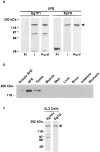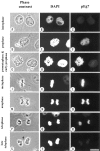pEg7, a new Xenopus protein required for mitotic chromosome condensation in egg extracts
- PMID: 9852142
- PMCID: PMC2132990
- DOI: 10.1083/jcb.143.6.1437
pEg7, a new Xenopus protein required for mitotic chromosome condensation in egg extracts
Abstract
We have isolated a cDNA, Eg7, corresponding to a Xenopus maternal mRNA, which is polyadenylated in mature oocytes and deadenylated in early embryos. This maternal mRNA encodes a protein, pEg7, whose expression is strongly increased during oocyte maturation. The tissue and cell expression pattern of pEg7 indicates that this protein is only readily detected in cultured cells and germ cells. Immunolocalization in Xenopus cultured cells indicates that pEg7 concentrates onto chromosomes during mitosis. A similar localization of pEg7 is observed when sperm chromatin is allowed to form mitotic chromosomes in cytostatic factor-arrested egg extracts. Incubating these extracts with antibodies directed against two distinct parts of pEg7 provokes a strong inhibition of the condensation and resolution of mitotic chromosomes. Biochemical experiments show that pEg7 associates with Xenopus chromosome-associated polypeptides C and E, two components of the 13S condensin.
Figures







Similar articles
-
Nucleolar association of pEg7 and XCAP-E, two members of Xenopus laevis condensin complex in interphase cells.J Cell Sci. 2003 May 1;116(Pt 9):1667-78. doi: 10.1242/jcs.00311. J Cell Sci. 2003. PMID: 12665548
-
A kinase-anchoring protein (AKAP)95 recruits human chromosome-associated protein (hCAP)-D2/Eg7 for chromosome condensation in mitotic extract.J Cell Biol. 2000 May 1;149(3):531-6. doi: 10.1083/jcb.149.3.531. J Cell Biol. 2000. PMID: 10791967 Free PMC article.
-
Condensins, chromosome condensation protein complexes containing XCAP-C, XCAP-E and a Xenopus homolog of the Drosophila Barren protein.Cell. 1997 May 16;89(4):511-21. doi: 10.1016/s0092-8674(00)80233-0. Cell. 1997. PMID: 9160743
-
SMC protein complexes and the maintenance of chromosome integrity.Curr Top Microbiol Immunol. 2003;274:79-112. doi: 10.1007/978-3-642-55747-7_4. Curr Top Microbiol Immunol. 2003. PMID: 12596905 Review.
-
Mitotic chromosome formation and the condensin paradox.Exp Cell Res. 2004 May 15;296(1):35-42. doi: 10.1016/j.yexcr.2004.03.006. Exp Cell Res. 2004. PMID: 15120991 Review.
Cited by
-
A human condensin complex containing hCAP-C-hCAP-E and CNAP1, a homolog of Xenopus XCAP-D2, colocalizes with phosphorylated histone H3 during the early stage of mitotic chromosome condensation.Mol Cell Biol. 2000 Sep;20(18):6996-7006. doi: 10.1128/MCB.20.18.6996-7006.2000. Mol Cell Biol. 2000. PMID: 10958694 Free PMC article.
-
The structural maintenance of chromosomes (SMC) family of proteins in mammals.Chromosome Res. 2001;9(2):85-96. doi: 10.1023/a:1009287518015. Chromosome Res. 2001. PMID: 11321372 Review.
-
Identification of post-transcriptionally regulated Xenopus tropicalis maternal mRNAs by microarray.Nucleic Acids Res. 2006 Feb 7;34(3):986-95. doi: 10.1093/nar/gkj492. Print 2006. Nucleic Acids Res. 2006. PMID: 16464828 Free PMC article.
-
Core histone N-termini play an essential role in mitotic chromosome condensation.EMBO J. 2000 Feb 1;19(3):379-91. doi: 10.1093/emboj/19.3.379. EMBO J. 2000. PMID: 10654937 Free PMC article.
-
Distribution of XCAP-E and XCAP-D2 in the Xenopus oocyte nucleus.Chromosome Res. 2003;11(6):549-64. doi: 10.1023/a:1024999316867. Chromosome Res. 2003. PMID: 14516064
References
-
- Adachi Y, Luke M, Laemmli UK. Chromosome assembly in vitro: topoisomerase II is required for condensation. Cell. 1991;64:137–148. - PubMed
-
- Bhat MA, Philp AV, Glover DM, Bellen HJ. Chromatid segregation at anaphase requires the barren product, a novel chromosome-associated protein that interacts with Topoisomerase II. Cell. 1996;87:1103–1114. - PubMed
-
- Bravo R, Knowland J. Classes of proteins synthesized in oocytes, eggs, embryos, and differentiated tissues of Xenopus laevis. . Differentiation. 1979;13:101–108. - PubMed
-
- Gasser SM. Chromosome structure. Coiling up chromosomes. Curr Biol. 1995;5:357–360. - PubMed
Publication types
MeSH terms
Substances
Associated data
- Actions
LinkOut - more resources
Full Text Sources
Other Literature Sources

